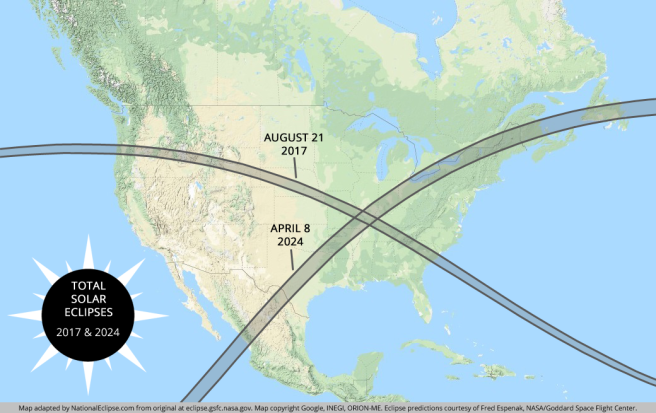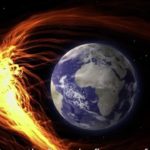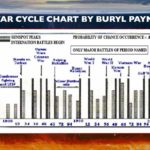X Marks the Spot: Two Total Solar Eclipses in Seven Years
It’s been said that, on average, a total solar eclipse can be seen from the same place only once every 375 years.
The methodology used by whoever calculated this number is unknown and it’s debatable whether there can even be a definitive methodology for such a calculation. For instance, how many points on Earth do you use to arrive at an average number of years? But regardless of the math, there’s no denying the fact that a total solar eclipse is a relatively rare event for any given place. So, for an area to get not one, but two, total solar eclipses in just seven years is a truly remarkable occurrence!
An area spanning parts of Missouri, Illinois, and Kentucky will be the nexus of the next two total solar eclipses to occur in the U.S., on August 21, 2017, and April 8, 2024. Because the 2017 eclipse travels across the country from northwest to southeast and the 2024 eclipse makes its way through the nation from southwest to northeast, the two paths cross each other and create a zone of overlapping totality of almost 9,000 square miles, or roughly the size of New Jersey.

Although no major American cities are located within the totality zone, a few decent-sized ones are. In Illinois, Carbondale is located in the northern quadrant of the zone and Marion is located in the eastern. In the southern quadrant there’s Paducah, Kentucky, and Cape Girardeau, Missouri. Farmington, Missouri, is located in the western quadrant. Shawnee National Forest is completely enclosed within the zone of totality and both the Mississippi and Ohio rivers run through it.
The centerline of any total solar eclipse path is where totality lasts the longest, and cities located on or near this line often promote themselves as being the very best place to view an eclipse. Of course, when two eclipse paths cross, there can only be one singular point on Earth where both centerlines meet. For the 2017 and 2024 eclipses, “X” marks the spot near the eastern shore of Cedar Lake in Jackson County, Illinois. Technically, the closest town to this exact astronomical treasure map spot is Makanda, population about 500. The nearest city of any size is Carbondale, located about three miles to the northeast. In fact, both Makanda and Carbondale are touting themselves as the place where the two centerlines cross, with Carbondale and its Southern Illinois University partner adopting the tagline “Eclipse Crossroads of America.” We’ll just split the difference and give Jackson County the bragging rights.

After 2024, eight more total solar eclipses will occur in the U.S. this century, resulting in a few more centerline crossings. We’ll dedicate a future blog post to discuss where and when these will occur, although some of us probably won’t be around for all of them. In the meantime, if you’d enjoy the unique distinction of seeing two total solar eclipses in one place, start making plans to be in southeastern Missouri, southern Illinois, or western Kentucky on August 21, 2017, and mark your calendar to do the same for April 8, 2024.
Visit NationalEclipse.com for more about eclipses, including information on the next total solar eclipse coming to America on April 8, 2024.





